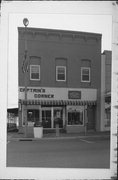Property Record
101 S WATER ST
Architecture and History Inventory
| Historic Name: | C.E. Rich Building |
|---|---|
| Other Name: | Captain's Corner/Sparta Area Chamber of Commerce |
| Contributing: | Yes |
| Reference Number: | 28011 |
| Location (Address): | 101 S WATER ST |
|---|---|
| County: | Monroe |
| City: | Sparta |
| Township/Village: | |
| Unincorporated Community: | |
| Town: | |
| Range: | |
| Direction: | |
| Section: | |
| Quarter Section: | |
| Quarter/Quarter Section: |
| Year Built: | 1890 |
|---|---|
| Additions: | 1975 |
| Survey Date: | 1989 |
| Historic Use: | retail building |
| Architectural Style: | Commercial Vernacular |
| Structural System: | |
| Wall Material: | Brick |
| Architect: | |
| Other Buildings On Site: | |
| Demolished?: | No |
| Demolished Date: |
| National/State Register Listing Name: | Water Street Commercial Historic District |
|---|---|
| National Register Listing Date: | 11/12/1992 |
| State Register Listing Date: | 7/3/1992 |
| National Register Multiple Property Name: |
| Additional Information: | The C.E. Rich Building was erected in 1890 and replaced another building on the southeast corner of South Water and East Main Street which was a photography studio. The present-day building started out as the Richardson and Foster photography studio on the East Main Street side and a millinery on the South Water Street side - with offices on the second floor. By 1897-1900, the Foster and Shidell photography studio moved next to the millinery on the South Water street, and the Herald Advertiser print shop moved into the East Main Street side of the building. By 1911, the Herald Adviser was no longer printing from the East Main Street side of the building. The entire building was now the home of art studio (photography shop) at this location, which probably was the H.W. Moll photography studio. From 1916 to at least 1931, the building was continually occupied by photographer studios. The C.E. Rich Building gains local significance under Criterion A as an example of the general mercantile businesses common in the late nineteenth and early twentieth centuries. As indicated within the Commercial Theme, these enterpriese (photography studios and newspaper publishing) played a central role in the growth and stability of the community's business. The period of historical significance extends from 1890 to perhaps as late as the 1930s. This commercial vernacular building is a small two-story, three-bay brick [presently painted] building, 25 ft. x 65 ft.] characterized by a moulded and corbeled brick cornice. The upper facade displays three segmental arched windows partially filled with small metal windows and partially with wooden panels. A contemporary storefront with a metal and glass recessed main entrance flanked by plate glass windows is located on the lower story of the facade. An entrance door to the second floor is located on the south end of the lower story. A canopy supported on wooden posts is located on the north side of the building. This small commercial building has been altered by the 1975 addition of replacement windows that are smaller than the original and by the addition of a contemporary storefront constructed in a modern style. This commercial vernacular building was constructed in 1890 as rental property for C.E. Rich. This building's first floor was used originally by the Richardson and Foster Photography Studio, who had occupied the frame building previously on the site that was move din 1890 to the rear of the lot and covered by metal. The second floor contained office space for rent. The photography studio under the proprietorship of the Richardson Brothers was moved from the premises to West Oak when the Rich Building was purchased by Meyer and Spencer for their new and used furniture store in 1923. The Rich Building does not meet the criteria of the NRHP for architectural significance because of a lack of integrity. However, this commercial vernacular building has sufficient architectural character to contribute to the proposed historic district. Better examples of the commercial vernacular building form are located at 111 East Oak (MO35/22) and 113-115 East Oak. |
|---|---|
| Bibliographic References: | (A) City of Sparta, WI, Community Development Office, Building Permit File. (B) City of Sparta Tax Records, 1890-1930. (C) Sparta Herald April 8, 1890; Sept. 9, 1890; May 15, 1923. (D) Sanborn Insurance Map 1889, 1894, 1900, 1911, 1922, 1931. (E) Annual Directory of Sparta, WI. Vol. 1. Chicago: Interstate Directory CO., 1897. (F) Sparta City Directory, 1903-1904. Sparta: R.C. Glover, Publisher, 1904. (G) City Directory of the City of Sparta, Wisconsin. Sparta: compiled and published by E.B. Bell, 1916. (H) "Sparta Recollections" Monroe County Historical Society, 20th edition (April 1978):4. |
| Wisconsin Architecture and History Inventory, State Historic Preservation Office, Wisconsin Historical Society, Madison, Wisconsin |

